#ranville
Text

Réplique du planeur Airspeed AS. 51 Horsa – Mémorial Pegasus – Ranville – Calvados – Février 2008
Photograhe : Fodfish
#WWII#royal air force#raf#aviation militaire#military aviation#avion de transport#transport aircraft#planeur#glider#Airspeed AS. 51 Horsa#horsa#mémorial pegasus#ranville#calvados#normandie#normandy#france#02/2008#2008
114 notes
·
View notes
Photo
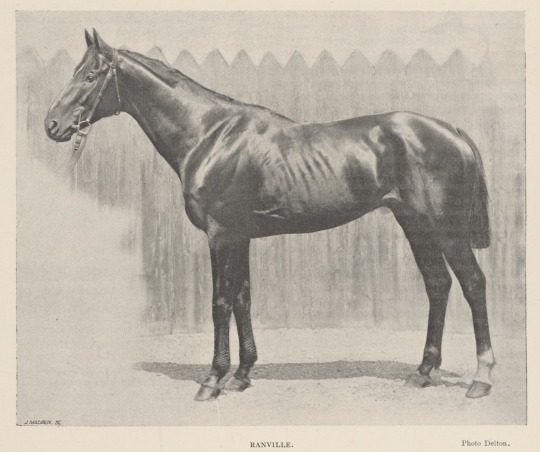
RANVILLE.
Photo Delton.
Le Sport Universel Illustrée, 1er Janvier 1896.
#cheval#pur sang#cheval de course#Thoroughbred#racehorse#Ranville#Louis-Jean Delton#Le Sport Universel Illustré#1896
16 notes
·
View notes
Text

MEMORIAL PEGASUS-RANVILLE (Stanley James Ledger « Speedy » Hill, né le 14 mars 1911 à Bath et mort le 16 mars 2006, est un officier britannique. Il participe à la Seconde Guerre mondiale où il est le commandant)
2 notes
·
View notes
Text

Lance Corporals A. Burton and L. Barnett of 6th Airborne Division guarding a road junction near Ranville, 7 June 1944.
30 notes
·
View notes
Photo

Θαρσείν χρη, τάχ’ αύριον έσσετ’ άμεινον. Eλπίδες εν ζωοίσιν, ανέλπιστοι δε θανόντες.*
- Theocritus
You need to have courage, because tomorrow will be better. While there's life there’s hope, and only the dead have none.*
My ex-regiment proudly traces its lineage back to the Glider Pilot Regiment which spearheaded British airborne forces to take Pegasus Bridge on D Day 6 June 1944. During my service I had the privilege to travel there and take part in the commemorative ceremonies whenever D Day came around. I loved listening to the stories of some of the surviving veterans and also some of the local French too. The British taking of Pegasus Bridge - re-named partly after the emblem of pegasus of airborne forces - was one of the stand out events of the first days of D Day by British forces.
Airborne landings in the British Sector were targeted mainly at the Orne River/Caen Canal crossings and the artillery installations of the Merville Battery. The strategic purpose was to secure river crossings for the beach break-out and to reduce enemy defences.

At 00:16 hours on 6th June parachutists and gliders from the Airborne Division, consisting of D Company of the Oxfordshire & Buckinghamshire Light Infantry, began to land east of the River Orne and the Caen Canal.
The small force of 181 men was commanded by Major John Howard and joined with a detachment of Royal Engineers who landed at Ranville-Benouville in six 28-men Horsa gliders. Having taken off from Dorset, the gliders were towed across the Channel by Halifax Bombers. With perfect navigation and piloting skill, the gliders landed on time and on target within few yards of each other.
Major Howard’s glider landed within a few feet of the canal bridge. The bridge was captured after a fierce ten minute fire fight, the action all over by 00:26, a full six hours before the beach landings.
But the success of the mission was also down to intelligence gathered by locals and passed onto British intelligence through the French resistance channels.
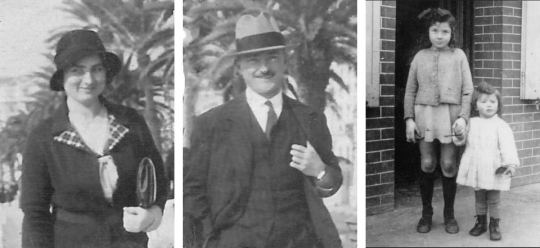
One of these was Georges Gondrée and his wife, Thérèse. Georges and Thérèse moved to Bénouville where they bought a small café in 1934 on the shore along the Bénouville Bridge, called Café Gondrée. During the Invasion, they had three small daughters: Georgette, Arlette, and the newborn Françoise.
The family certainly hated the German occupation. Among other things, they refused to allow their café to serve as a billet for German soldiers. But they went further by joining the French resistance at great danger to themselves.
As the war progressed, the more risks and dangerous activities they undertook against the Germans. Thérèse, who grew up in Alsace, knew quite a bit of German. Local residents did not like her Germanic Alsatian accent but she took care to keep her knowledge of German secret from the German soldiers themselves. This often helped her to eavesdrop on conversations of the soldiers and then pass on important information to the resistance through her husband, Georges. There were a few times when they were nearly caught but somehow they survived.
The information gathered by the Gondrée family contributed greatly to the insight of Major Howard and his troops to better assess the defensive positions around the bridge. Among other things, Thérèse was able to pinpoint the exact location of the detonator that was supposed to have detonated the bridge during the attack. Georges was also known to British intelligence and even Major Howard had heard his name mentioned during the planning of the invasion itself.
The importance of the family’s contribution to the success of the British attack can also be seen from an example during early May 1944. When Field Marshal Erwin Rommel came to inspect the bridge, he had given the order to place an anti-tank gun beside the Bénouville Bridge. Within two days Major Howard had been informed that a new structure was being built along the bridge and within a week Georges’ observation had helped to confirm both its function and exact location.

So, just 90 minutes after taking off from RAF Tarrant Rushton in England, Major Howard was able to send the code words “Ham and Jam”, indicating that both bridges had been captured. In this early action of D-Day, the first house on French soil was liberated, and the first British soldier of the Normandy Invasion was killed in action: Lieutenant Den Brotheridge.
It was No. 1 Platoon which knocked out a machine gun position firing from the bridge and rushed across to capture the far side, firing from the hip and lobbing grenades during the charge. Lt. Brotheridge was mortally wounded by gunfire as he made a grenade attack on a second machine gun position. The bridge had been prepared by the enemy for demolition, although the Royal Engineers removed the unset charges.
Within half an hour of the bridge being taken, 6th Airborne parachutists landed to provide reinforcement. The Ox & Bucks were reinforced half-an-hour after the landings by 600 men of 7th Battalion, the Parachute Regiment who were the relieving force to bear the brunt of German counter-attacks to the west of the Caen Canal throughout the 6th of June.
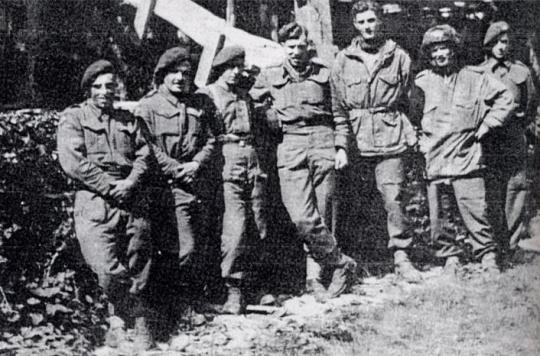
The Battalion distinguished itself in holding a wide bridgehead around ‘Pegasus Bridge’ against constant enemy attacks which were often armour supported. In particular the “A” Company, based in the nearby village of Bénouville, suffered the most severe fighting and were eventually cut off from the remainder of the 7th Battalion.
The first relief in force was from 6 Commando, led by the commander of the 1st Special Service Brigade, Lord Lovat, who arrived to the sound of the Scottish bagpipes, played by the 21–year-old so-called ‘Mad Piper’, Private Bill Millin.
The remnants of the 7th Battalion’s “A” Company continued to hold out until 9:15pm on the 6th June when British infantry, in the form of the 2nd Battalion The Royal Warwickshires, arrived from the invasion beaches and secured Bénouville, and so allowed the evacuation of “A” Company’s many wounded.
In honour of the distinctive emblem of the Parachute Regiment, the distinctive bridge at Benouville was renamed and will forever be known as “Pegasus Bridge”.

Arlette Gondrée being kissed by two veterans who remember her parents.
Over the years, many thousands of pairs of British boots have crossed the threshold of the Café Gondrée. General Montgomery in 1945, veterans paying tribute to fallen comrades and numerous members of the Royal family. Arlette Gondrée, the daughter of Georges and Thérèse, still recalls with crystal clarity the very first occasion a British soldier arrived at the cafe on the night of June 5, 1944, when she was just four-years-old, cowering with her family in the basement during the start of the D-Day invasion.
Commemorating the landings in 1945, General Montgomery visited the Café Gondrée Pegasus Bridge, renamed after the winged emblem of the British 6th Airborne Division, with some widows of the soldiers lost in the Normandy campaign. Georges produced some of the vintage champagne he had hidden, including a 1926 Pouilly-Fuissé.
Over the ensuing years, the family never ceased to celebrate their liberation. “Daddy would make a large U-shaped table in the café and we would eat together as a happy family, and very, very thankful to the British for what they did for us. And that remains so to this day.”
Life was hard for years, made worse by rationing. The effect of the ordeal on the girls was subtle, but not invisible: in November 1944, the Red Cross visited and told Arlette if she stopped biting her nails, they would give her a real doll to replace her cardboard toy. The café didn’t open properly again until June 1945.

To this day, Mme Gondrée keeps her “little house” as a shrine to the British Airborne forces that liberated her family. She has said that she always felt honoured to have the privilege of being custodian of the memories of that fateful day.
Photo: Major John Howard is flanked by George Gondrée and Lt. David Woods raising a glass to the successful capture of Pegasus Bridge that day.
#theocritus#greek#classical#quote#D Day#DDay#British army#second world war#pegasus bridge#glider pilot regiment#gondree cafe#georges gondree#therese gondree#arlette gondree#major john howard#lt david woods#military history#french resistance#history#courage#bravery
60 notes
·
View notes
Text
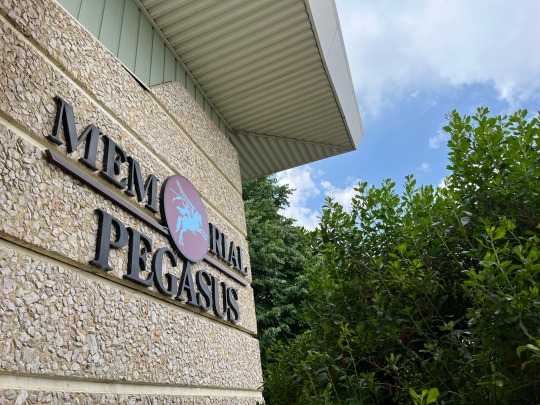
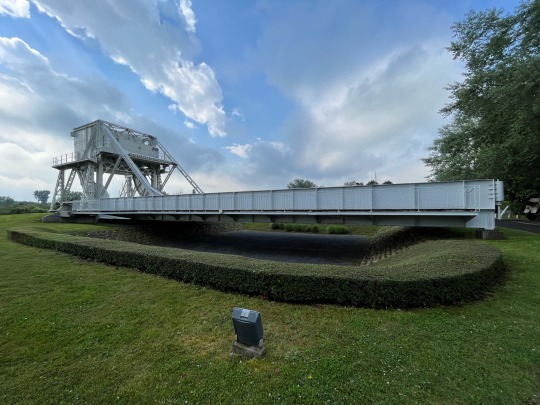



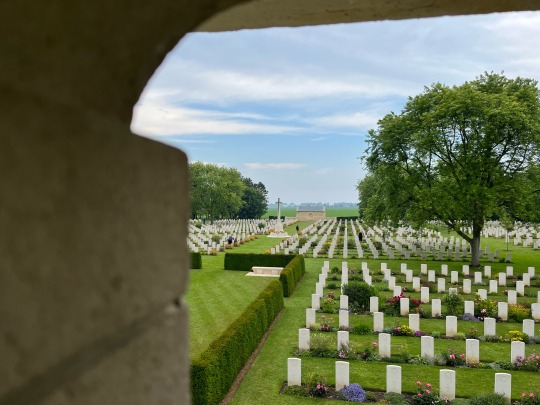
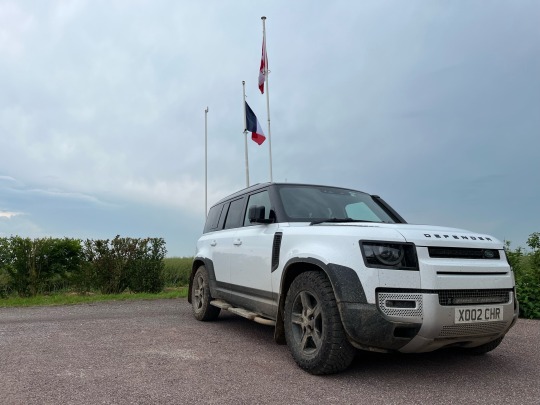



04/06/2022 - Day 1
The location for the group to meet was just a stones throw from Pegasus bridge located in Bénouville. Here we met some familiar faces from a previous BF4x4 tour we did a few years ago. As always an introduction and agenda was shared where most of this tour will be spent in the Calvados (Normandy) area.
Today's agenda
Pegasus Bridge Memorial
Ranville War Cemetery
Colleville-Montgomery - The Hillman Fortress
Bény-sur-Mer Canadian War Cemetery
Arromanches-les-Bains - The Mulberry Harbour/Port Winston
Memorial Pegasus
As you would've guessed our first stop was indeed Pegasus bridge memorial/museum, now i'd imagine most would know this but the original captured bridge has been relocated away from the canal and the one you drive/walk over is a replica.
The site is dedicated to the men of the British 6th Airborne Division who were the first Allied troops to arrive in Normandy on the night of the 5th/6th of June 1944 where a small detachment of the 6th British Airborne Division surprised the German garrison guarding the bridges. The BF4x4 guides arranged for a guided tour to walk us through step by step how the assault unfolded and we were even lucky enough to meet a veteran - Well worth a visit.
Ranville War Cemetery
1.4 kilometres down the ride (3 minute drive) is the Ranville War Cemetery. Ranville was the first village to be liberated in France when the bridge over the Caen Canal was captured intact in the early hours of 6th June by troops of the 6th Airborne Division, who were landed nearby by parachute or glider. Many of the division's casualties are buried in Ranville War Cemetery.
The cemetery contains around 2,236 Commonwealth burials of WW2, 90 of them unfortunately are unidentified and 323 German graves. The churchyard also contains 47 Commonwealth burials, one of which is unidentified, and one German grave.
One grave of interest was of Private Emile Corteil, he was from Watford in Hertfordshire and served with A Company, 9th (Essex) Parachute Battalion. Corteil was the dog handler for the company, and his dog was called Glen. Both parachuted into France with their company on D Day, Emile was killed on D Day aged 19 years; Glen was also killed and the two were found lying together.
Colleville-Montgomery - The Hillman Fortress
From Ranville we head 7.5km northwest to The Hillman Fortress which sits south of the town Collevill-Montgomery. The Hillman Fortress was a command post among the German coastal defences on the Normandy beaches which was built between 1942 and 1944.
The 1st Battalion, Suffolk Regiment liberated the site on the 6th of June 1944 but took longer than expected. The delay in taking the bunker complex has been cited as a reason for the Allies not completing their major D-Day objective of taking Caen.
We were fortunate to experience a camp reenactment, this entailed enthusiasts dressing up as allies and Germans with decommissioned weapons and WW2 vehicles. 1940's radio's playing war speeches and also the Jive music like 'Boogie Woogie Bugle Boy' by The Andrews Sisters. It's honestly awesome to be amongst it and i'm sure many have got bitten by the reenactment bug. Once we had completed many laps of the camp and the fortress we has a spot to eat in the back of the 110 mainly cheese, ham and baguette (continental lunch) before heading off to our next destination of the day.
Bény-sur-Mer Canadian War Cemetery
Whilst in convoy heading west over the CB radio Keith informs us that we will be stopping off at another war cemetery, but this contains mostly Canadians. Many of those buried were of the 3rd Canadian Division who died either on 6th June or during the early days of the advance towards Caen, when the Division engaged the German 716th Division and the 21st Panzer Divisions.
As you look around any war cemetery it is hard to really comprehend that each headstone represents a lost life and though i'm stating the obvious it's just an overwhelming experience.
Arromanches-les-Bains - The Mulberry Harbour/Port Winston
And just when you thought the day was drawing to an end, when arriving at our accommodation for the next couple of nights which is the very nice Chateau de Bellefontaine. The guys at BF4x4 explained after checking in and freshening up we have a table booked at La Marine which overlooks Gold beach, where the remains of the Mulberry Harbour/Port Winston lie.
It was part of mission overlord, where the objectives at Gold Beach were to
- Secure a beachhead
- Move west to capture Arromanches
- Establish contact with the American forces at Omaha
- Capture Bayeux and the small port at Port-en-Bessin
- Link up with the Canadian forces at Juno to the east
The forces attacking Gold beach faced the German 352nd Infantry Division and German 716th Infantry Division and there were around 350 ally fatalities.
Mulberry "B" (British) was the harbour assembled on Gold Beach at Arromanches for use by the British/Canadian forces. The harbour was decommissioned 6 months after D-Day as the Allies were able to use the recently captured Antwerp port. The harbour was operated by 20 Royal Engineers under the command of Lt. Col. G C B Shaddick.
That will be enough about the history, the food at La Marine was fantastic and the on the house calvados shot (cider brandy) definitely opened up the airways.
Based on Day 1... tomorrow is going to be another epic day.
#landrover#defender#landroverdefender#overlander#4x4#defendertd5#overland#td5#defender110#land rover defender#battlefields4x4
13 notes
·
View notes
Text

Questo non vuol dire che siccome sei pieno di rabbia, dolore o frustrazione riversi sul prossimo la tua interiorità, piuttosto significa che finalmente la osservi con attenzione e ti rendi responsabile dei pensieri che hai e delle emozioni che provi.
Perché, se avessi ancora qualche dubbio, il tuo stato psico-fisico non si genera autonomamente, ma ti prende in ostaggio di ripetizioni, istinti e convinzioni quando non rendi cosciente te stesso.
Cosciente, non in balia di rimuginii e ruminazioni mentali.
Se vuoi cominciare da segnali fisici, suggerisco Ogni sintomo è un messaggio di Claudia Ranville.
#zombie#società malata#consapevolezza#malattia#rabbia#dolore#auto osservazione#lavoro su di sé#conosci te stesso#crescita interiore#crescita personale#società#svegliatevi#evoluzioni#citazioni#manipolazioni#aprite gli occhi#sistema#suggerimenti#libri
68 notes
·
View notes
Photo

5 June 2014 | Prince Charles, Prince of Wales meets veterans near Pegasus Bridge (Also known as the Bénouville Bridge - The taking of the Bridge was an important strategic victory) during D-Day Commemorations in Ranville, near Caen in Normandy, France. Friday 6th June is the 70th anniversary of the D-Day landings which saw 156,000 troops from the allied countries including the United Kingdom and the United States join forces to launch an audacious attack on the beaches of Normandy, these assaults are credited with the eventual defeat of Nazi Germany. A series of events commemorating the 70th anniversary are planned for the week with many heads of state travelling to the famous beaches to pay their respects to those who lost their lives. (c) Matt Cardy/Getty Images
14 notes
·
View notes
Text
Tonight and Tomorrow the Roxy is excited to that the Legendary and incomparable Mr. Errol Ranville & Cweed Band performing at The Roxy Saskatoon. Shoes start 10:00 and tickets are at the door!

0 notes
Photo
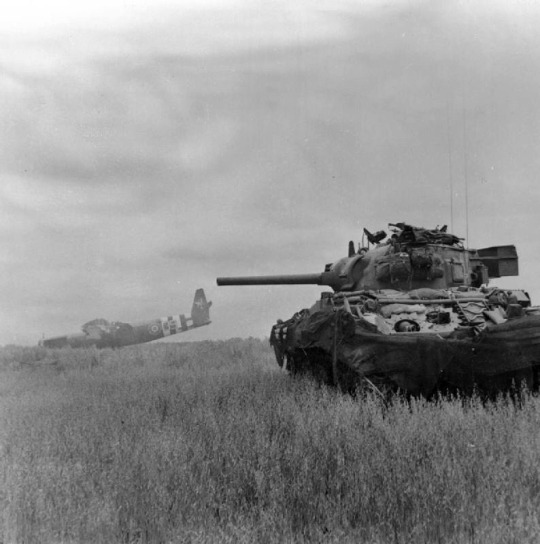
Sherman DD amphibie du 13th/18th Royal Hussars (Régiment de cavalerie britannique) en action dans le secteur de Ranville - Bataille de Normandie - Ranville - Calvados - Normandie - France - 10 juin 1944
Photographe : Sergent Christie - No. 5 Army Film and Photo Section, Army Film and Photographic Unit
©Imperial War Museums - B 5348
#WWII#Opération Overlord#Overlord#Bataille de Normandie#Battle of Normandy#Armée britannique#British Army#13th/18th Royal Hussars#Char#Tanks#Char moyen#Medium tank#M4 Sherman#M4 Sherman DD#Ranville#Calvados#Normandie#Normandy#France#10/06/1944#06/1944#1944
98 notes
·
View notes
Video
youtube
Errol 'C-Weed' Ranville - I Want To Fly - No. 1 West - 1987
0 notes
Text



MEMORIAL PEGASUS-RANVILLE (Pégasus Bridge)
2 notes
·
View notes
Text
I've never met God, but I like His house. It's a feature of my Presbyterian, Church of Scotland upbringing melded with my interest in history. The mashup of spiritual and temporal power displayed in a cathedral holds endless interest for me - A king or a duke or a conquistador saying "Yes, I built this to the glory of God, but bear in mind that my culture and belief system is supreme and look how fucking rich I am."
There's a church in France I visited last month in a small village called Ranville. I went to Bayeux Cathedral, consecrated by William the Conqueror (an undeniable upgrade on his previous sobriquet of Bastard) and to Poitiers Cathedral, it's construction begun by Henry II and Eleanor of Aquitaine, who had married in the city. But Ranville, the smallest and plainest of the three is in some ways the most interesting. It's old, very old. Originally Norman, I believe, and architecturally curious. The bell tower is separate from the main building of the church, something I've never seen before. That oddity wasn't why I went there, though.
I was in France visiting friends I hadn't seen since 2018. The Before Times, as it were. They live in Aquitaine, but my friend Jon suggested we take a trip to Normandy for a couple of days to see some Second World War sites while his wife worked at home. Wasn't even my idea. I didn't have to twist his arm at all.
On my birthday we went to the Musee des Blindes in Saumur on the Loire - the French tank museum - where I, happy as a pig in shit, explained some of the positives and negatives of such marvels as the Tiger, T-34, Comet and Sherman, and then we drove to Bayeux. The next day we visited some of the most famous sites associated with D-Day: Juno Beach, where the Canadians came ashore; Pegasus Bridge, seized by glider-borne infantry before 15 minutes had passed that day; and the Merville Battery where 150 men of the 6th Airborne Division destroyed the guns in an attack originally planned for a full battalion of 650 paratroops.
And we went to Ranville.
A landmark as distinctive as the church made an obvious RV point for paratroopers scattered across the French countryside. The first British soldier killed on D-Day is buried in Ranville's churchyard. Shot through the neck storming Pegasus Bridge, he lies 10 yards away from where a Para had a lucky escape when a German shot at him with a burst from a submachine gun, narrowly missing his head. You can still see the bullet holes in the wall of the church.
Another 45 soldiers lie in the churchyard and 2,560 in the sombrely beautiful graveyard beside it, 322 of them German, the rest Allied, mostly British. Most are known, their names inscribed along with their ages, date of death, regiment and regimental insignia in headstones made of marble or sometimes concrete. They often have epitaphs, one 19-year-old's grave having a message from his parents saying that they gave their son so that the sons of others could live. Stones lie on top of some, a Jewish tradition Jon told me, showing that someone had visited the grave and remembered. A number of graves have double headstones, a reminder that sometimes, multiple men are killed simultaneously, leaving not enough of either victim's body to identify or separate them. And so two or more men are buried in a single grave.
We went to Ranville because when reading and talking about war, it's easy to get carried away with events like the assault on Pegasus Bridge or the daring attack at Merville, and it's very easy to get caught up in objectively cool things like Tiger tanks.
You have to remember the truth of war. Soldiers - often far younger than the actors who play them in movies - lying side-by-side in cemeteries because their commanders decided the land they were on was important enough to fight and kill and die for. In this case I know the price was worth it, because I stood in another church a few days later, this time in Oradur-Sur-Glane, whose desecrated, burnt out walls stand in permanent memorial to hundreds of civilians murdered there by men of the 2nd SS Panzer Division Das Reich on the 10th of June 1944. But most often, the cost of war is vastly overpaid.
As we were leaving Ranville, Jon remarked that war cemeteries are always beautifully kept, and he's right. The Commonwealth War Graves Commission do wonderful work, keeping grass mown and bushes symmetrically pruned. But it's because we've given them too much practice.

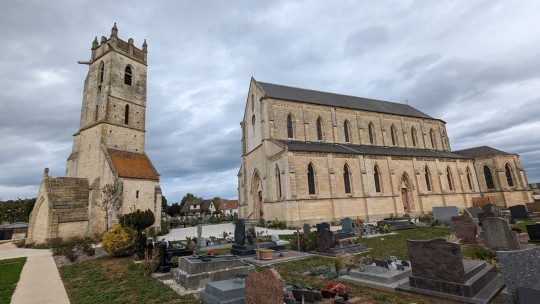

#Writing#World War 2#Churches#War is fucking awful#however bad you've imagined war to be it is much much worse
0 notes
Photo

British Paratroopers of 12th Parachute Battalion, 5th Parachute Brigade, 6th Airborne Division, enjoy a cup of tea after fighting their way back to their own lines after three days behind enemy lines near Ranville, Normandy, France. 10 June 1944
8 notes
·
View notes
Photo

Cimetiere de Ranville,Calvados, France.
Photographed by Christophe Maitrejean.
#photographers on tumblr#cimetiere militaire#ranville#calvados#farnce#Military Graves#Cemetery#taphophilia#ww2#war memorial
17 notes
·
View notes
